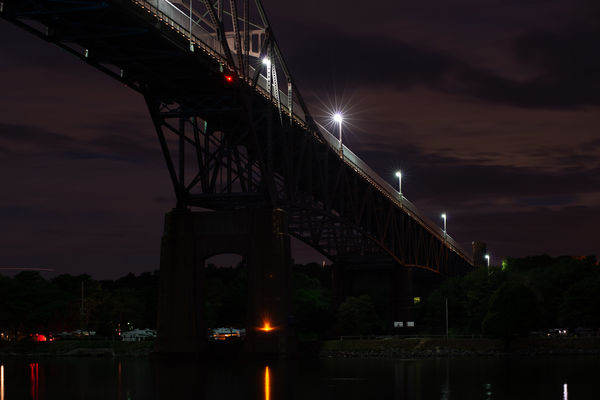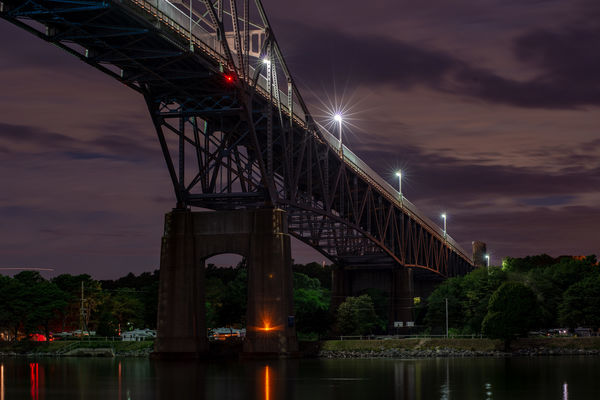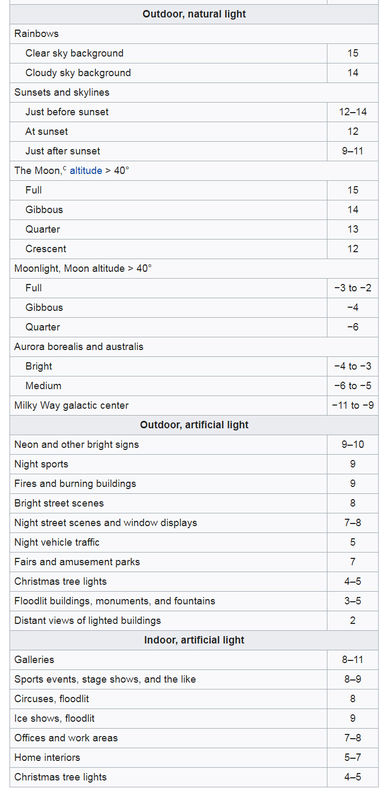Exposing to the right
Nov 10, 2018 16:54:33 #
gunflint wrote:
... My question is (and I will do some tests myself) does this "rule" apply for night photography such as city lights after dark? Any tips from those with experience at this is appreciated!
It does but the dynamics are different.
The easiest way to get it to work is by exposing so that the blinkies just barely begin to flash (you must be shooting raw). If you go too far the colors of the brightest lights will start to change.
The histogram(s) won't help because the lights might be too small to show there.
As for noise in the shadows, the first thing to consider is whether the shadows are important. Pure black is better than noisy black. The easiest way to clean up noise in the deep shadows is to just raise the black point and obliterate it.
Nov 10, 2018 17:00:38 #
gunflint wrote:
For my daytime exposures I have been attempting to always expose to the right and watching the histogram as to not clip any whites or blacks. It does seem to help with the dynamic range.
My question is (and I will do some tests myself) does this "rule" apply for night photography such as city lights after dark? Any tips from those with experience at this is appreciated!
My question is (and I will do some tests myself) does this "rule" apply for night photography such as city lights after dark? Any tips from those with experience at this is appreciated!
At night I don't avoid overexposing lights and such at the expense of getting muddy shadows. Lights are generally expected to lack detail.
no processing D800, 80-200 F2.8, F6.3, ISO 100, 30 sec exposure

(Download)
after adjustments in Lightroom.

(Download)
Nov 10, 2018 17:45:08 #
Gene51 wrote:
At night I don't avoid overexposing lights and such at the expense of getting muddy shadows. Lights are generally expected to lack detail.
The exposure you used (F6.3, ISO 100, 30 sec) works out to EV=0.33. According to the recommendations from Exposure value (see attached excerpt) that's about two stops brighter than the standard recommendation for "Distant views of lighted buildings". Based on that table, I would have started with 8 sec @ 5.6 or equivalent.
I don't recommend avoiding the blinkies for the street lights themselves. What I was referring to earlier was colored neon lights which are much less bright. They call for an exposure value of about 9-10. If they are blown out you will lose some or all of their color.
With adjustments during the raw conversion your image worked out nicely. It shows that the actual exposure is not critical.
Anyone trying this for the first time, since they will have the camera on a tripod anyhow, should take the time to expose such a scene +2 and -2 stops from their best guess.
Nov 10, 2018 18:41:46 #
Gene51 wrote:
At night I don't avoid overexposing lights and such at the expense of getting muddy shadows. Lights are generally expected to lack detail.
Absolutely perfect example.
Andy
Nov 10, 2018 18:50:49 #
selmslie wrote:
The exposure you used (F6.3, ISO 100, 30 sec) work... (show quote)
If I were shooting film I don't think I would have done any differently. The goal in both cases is to sacrifice the highlights and make sure you get the shadows covered. It was quite dark where I was shooting - the Cape Code Canal just north of the Bourne Bridge. Had to use a headlamp with a red filter on it so I could see my camera and not trip over the tripod legs.
Nov 10, 2018 18:50:59 #
AndyH wrote:
Absolutely perfect example.
Andy
Andy
Thanks!
Nov 10, 2018 19:51:46 #
Gene51 wrote:
If I were shooting film I don't think I would have done any differently. The goal in both cases is to sacrifice the highlights and make sure you get the shadows covered. ...
You don't actually sacrifice the highlights with negative film like you do with digital. Film doesn't blow out like digital because it don't stop recording abruptly at a specific light level like 14-bit binary 16,383. Negative film usually has a round shoulder and it can accept an exposure far above the limit of digital.
I would not use film for long exposures anyhow because of reciprocity failure and color shifts that end up becoming a post processing challenge.
The only film that seems to extend the reciprocity exposure time range above 1 second is Fuji Acros and it seems to be free of reciprocity failure up to about 2 minutes and then only a half stop up to 15 minutes, according to Fuji. But why record a night scene in B&W?
If you look closely at the numbers here you can see that even digital starts to have a problem with color balance when overexposed. Look at the ratios of the maximum values of green and blue. As you get into the 8000-16000 range their proportions start to change.
When the digital raw file blows out in only one or two channels, the green channel does not seem to reach the 16,383 level although the blue channel does. Nevertheless, once all three channels blow out like they would with street lights you are left with pure white with all three channels at their maximum values.
Nov 11, 2018 05:55:44 #
Nov 11, 2018 07:06:37 #
Linda,
I do not think the link is correct. However, I did a search at the same site and came up with this link:
https://digital-photography-school.com/exposing-to-the-right-on-your-eos-camera/
Mark
I do not think the link is correct. However, I did a search at the same site and came up with this link:
https://digital-photography-school.com/exposing-to-the-right-on-your-eos-camera/
Mark
Linda From Maine wrote:
That seems to be the key point to the whole exercise.
From https://digital-photography-school.com/exposing-to-the-right/:
The resulting file, when processed back to the correct exposure, will contain more tonal information and less noise in the shadow areas, maximising your image quality.
From https://digital-photography-school.com/exposing-to-the-right/:
The resulting file, when processed back to the correct exposure, will contain more tonal information and less noise in the shadow areas, maximising your image quality.
Nov 11, 2018 07:08:55 #
Linda,
The link you provided does not seem to work. I did a search at the same site and found this reference to ETTR & exposing to the right.
https://digital-photography-school.com/exposing-to-the-right-on-your-eos-camera/
Mark
The link you provided does not seem to work. I did a search at the same site and found this reference to ETTR & exposing to the right.
https://digital-photography-school.com/exposing-to-the-right-on-your-eos-camera/
Mark

Linda From Maine wrote:
That seems to be the key point to the whole exercise.
From https://digital-photography-school.com/exposing-to-the-right/:
The resulting file, when processed back to the correct exposure, will contain more tonal information and less noise in the shadow areas, maximising your image quality.
From https://digital-photography-school.com/exposing-to-the-right/:
The resulting file, when processed back to the correct exposure, will contain more tonal information and less noise in the shadow areas, maximising your image quality.
Nov 11, 2018 07:19:27 #
City lights after dark will present specular highlights. In my view, then, you should expose for the rest of the scene using whichever technique serves your purpose.
gunflint wrote:
For my daytime exposures I have been attempting to always expose to the right and watching the histogram as to not clip any whites or blacks. It does seem to help with the dynamic range.
My question is (and I will do some tests myself) does this "rule" apply for night photography such as city lights after dark? Any tips from those with experience at this is appreciated!
My question is (and I will do some tests myself) does this "rule" apply for night photography such as city lights after dark? Any tips from those with experience at this is appreciated!
Nov 11, 2018 08:17:27 #
markngolf wrote:
Sorry, I inadevertently included a colon at the end of the line. Usually I double-check after I post a link Linda,
The link you provided does not seem to work. I did a search at the same site and found this reference to ETTR & exposing to the right.
https://digital-photography-school.com/exposing-to-the-right-on-your-eos-camera/
Mark
The link you provided does not seem to work. I did a search at the same site and found this reference to ETTR & exposing to the right.
https://digital-photography-school.com/exposing-to-the-right-on-your-eos-camera/
Mark


https://digital-photography-school.com/exposing-to-the-right/
I didn't compare the info with your own link (I tried ETTR once and decided it wasn't for me).
Nov 11, 2018 08:27:47 #
I understand. Mine was different, but covered the same topic.
Thanks,
Mark
Thanks,
Mark
Linda From Maine wrote:
Sorry, I inadevertently included a colon at the end of the line. Usually I double-check after I post a link

https://digital-photography-school.com/exposing-to-the-right/
I didn't compare the info with your own link (I tried ETTR once and decided it wasn't for me).

https://digital-photography-school.com/exposing-to-the-right/
I didn't compare the info with your own link (I tried ETTR once and decided it wasn't for me).
Nov 11, 2018 09:23:26 #
Linda From Maine wrote:
That seems to be the key point to the whole exercise.
From https://digital-photography-school.com/exposing-to-the-right/:
The resulting file, when processed back to the correct exposure, will contain more tonal information and less noise in the shadow areas, maximising your image quality.
From https://digital-photography-school.com/exposing-to-the-right/:
The resulting file, when processed back to the correct exposure, will contain more tonal information and less noise in the shadow areas, maximising your image quality.
I just learned that trick. I was looking forward to reading that article; but it is no longer at the link you provided.
EDIT: I see this is already corrected.
Nov 11, 2018 09:34:39 #
BebuLamar wrote:
You must shoot RAW to do expose to the right any way.
Exposing to the right means pushing the histogram to the right. I use the histogram in my M43 displays to help when I feel the need to compensate exposure - whether shooting JPG or RAW or JPG+RAW. If shooting JPG I still have the choice of ETTR or ETTL - in fact it can be more important - simply because recovery of lost detail either end may not be possible. Shadows I can live with - blown highlights I cannot - ETTR will help me decide how far I dare push it. So get off your high horse.

If you want to reply, then register here. Registration is free and your account is created instantly, so you can post right away.









